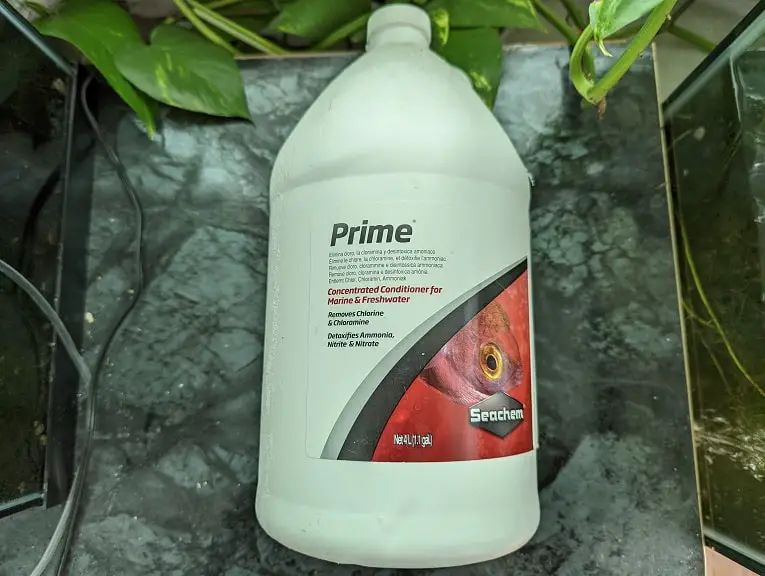Shrimps are a lot more fragile when compared to a vast majority of fish species in the aquarium hobby. Therefore, you need to be a lot more careful when cycling a new shrimp tank.
To see how you can quickly and safely build up the biological filtration of your new aquarium, you can take a look at this article from Aquarium Blueprints.
Recommended Products
In order to quickly and safely cycle your shrimp tank, we recommend that you get the following products:
With the Seachem Aquavitro Seed Aquarium Treatment, you can quickly add beneficial bacteria to your tank instead of starting from square one. The live colonies will quickly establish your biological filtration, which will help remove the toxic ammonia, nitrites and nitrates from your tank waters.
While the bacteria colonies that consume ammonia and nitrites will grow all over the tank, the bacteria species that consume nitrates will grow only in areas that are devoid of oxygen. So, in order to keep nitrate levels low in your shrimp tank, we recommend that you add Seachem Matrix.
Lava rocks will also help reduce ammonia, nitrites and nitrates. You can also stack these rocks on top of each other to create small caves for your shrimps to hide in.
You might also want to use Bacter AE, which is a product that will grow biofilm all over your tank. Your shrimps will graze on these films, which will help their survival rate.
Furthermore, we recommend adding live plants as these will also help keep the ammonia, nitrites and nitrates levels in check while also providing hiding spots for your pet inverts.
By turning up the water temperature, you can speed up the reproduction rate of beneficial bacteria. As a result, you will be able to cycle your new shrimp tank a lot faster. Therefore, we recommend that you use a heater as well.
If you are using tap water for your aquarium, then the chlorine and chloramine could end up harming your beneficial bacteria. In this case, we recommend using Seachem Prime. The water conditioner is designed to remove chlorine and chloramine from the tap water in addition to detoxifying ammonia, nitrites and nitrates.

You will also need a test kit to see if the tank water is suitable for shrimps. We recommend getting the API Master Test Kit.
Last but not least, you need an ammonia source to kickstart the cycling process for your brand-new shrimp tank. We recommend that you use a small pinch of fish food or shrimp food as these will decompose and eventually turn into ammonia.
If you are interested, you can purchase some of these recommended products on Amazon with the following links:
- Seachem Aquavitro Seed Aquarium Treatment(#CommissionsEarned)
- Bacter AE(#CommissionsEarned)
- Seachem Matrix Bio Media(#CommissionsEarned)
- Seachem Prime Water Conditioner(#CommissionsEarned)
- API Master Test Kit(#CommissionsEarned)
How to safely cycle a new shrimp tank as soon as possible
To cycle a new shrimp tank as soon as possible, we recommend that you take the following steps:
1. If you haven’t done so already, make sure you add the substrate, rock, filter, heater and décor into the tank.
2. Make sure you also add live plants and Seachem Matrix to your tank as well if you have these products on hand.
3. Next, you need to fill the tank with water. If you are using tap water, you need to also add Seachem Prime to get rid of the chlorine and chloramine from the tap water.
For Prime, you need to dose 5 mL for every 50 gallons (or 200 liters) of tank water.
4. With the heater fully underwater, plug it into the power outlet and then set the heater to within the range of 80°F to 87°F degrees (or 27°C to 30°C).
5. Next, you need to add Aquavitro Seed into your shrimp tank.
For Seed, you need to first shake the bottle well. You then need to dose 5 mL for every 10 gallons (or 40 liters) of tank water.
6. If you have Bacter AE, then this is also a good time to start adding the specialized powder to your tank as well.
7. Afterwards, drop in a small pinch of shrimp food or fish food into the aquarium.
If you are using pellets, then we recommend that you crush the food so that the smaller bits can decompose faster in the water.
8. Keep dosing Aquavitro Seed and adding a small pinch of food into the shrimp tank daily for one week.
For subsequent doses, you can add 5 mL of Seed for every 20 gallons (or 80 liters) of tank water.
9. After one week has passed, we recommend that you test out your tank water. For a fully cycled shrimp tank, the test kit needs to show 0 ppm of ammonia, 0 ppm of nitrites and less than 20 ppm of nitrates.
If the test kit shows that your tank is not cycled, then you need to add a capful (5 mL) Aquavitro Seed in addition to a small pinch of food before re-testing the tank water on a daily basis until your aquarium is fully cycled.
10. Once the test kit shows that your shrimp tank is fully cycled, you should be able to safely add shrimps to the aquarium.
Before doing so, make sure you re-adjust your heater to a more appropriate temperature range for your shrimp species.
11. After adding shrimps to the tank, we recommend adding Aquavitro Seed one more time as an extra precaution. You should dose Seed anytime you add new livestock to the aquarium.
Your shrimp tank should be fully cycled as this point. With that said, we recommend that you test your tank water once a week to see if there are any issues.
